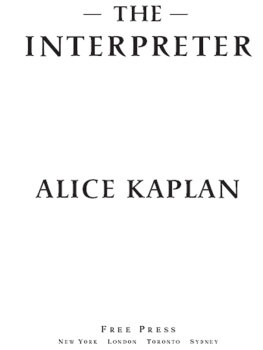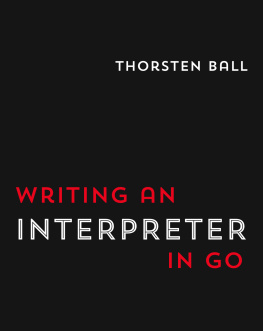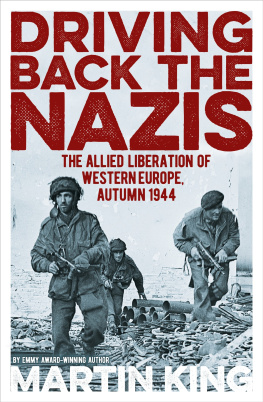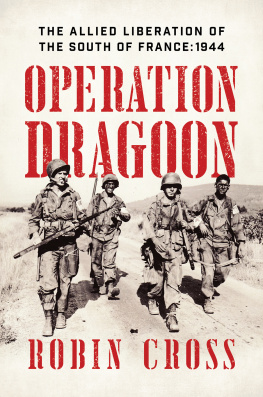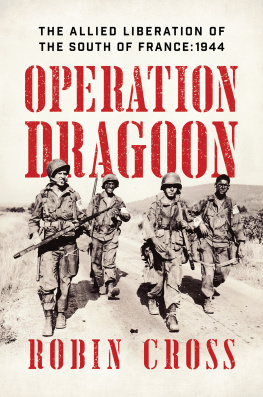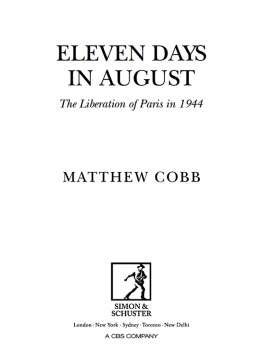Alice Kaplan - The Interpreter
Here you can read online Alice Kaplan - The Interpreter full text of the book (entire story) in english for free. Download pdf and epub, get meaning, cover and reviews about this ebook. year: 2005, publisher: Free Press, genre: Detective and thriller. Description of the work, (preface) as well as reviews are available. Best literature library LitArk.com created for fans of good reading and offers a wide selection of genres:
Romance novel
Science fiction
Adventure
Detective
Science
History
Home and family
Prose
Art
Politics
Computer
Non-fiction
Religion
Business
Children
Humor
Choose a favorite category and find really read worthwhile books. Enjoy immersion in the world of imagination, feel the emotions of the characters or learn something new for yourself, make an fascinating discovery.
- Book:The Interpreter
- Author:
- Publisher:Free Press
- Genre:
- Year:2005
- Rating:4 / 5
- Favourites:Add to favourites
- Your mark:
The Interpreter: summary, description and annotation
We offer to read an annotation, description, summary or preface (depends on what the author of the book "The Interpreter" wrote himself). If you haven't found the necessary information about the book — write in the comments, we will try to find it.
One of the least-known stories of the American liberation of France, from 1944 to 1946, is also one of the ugliest and least understood chapters in the history of Jim Crow. The first man to grapple with this failure of justice was an eyewitness: the interpreter Louis Guilloux. Now, in The Interpreter, prize-winning author Alice Kaplan combines extraordinary research and brilliant writing to recover the story both as Guilloux first saw it, and as it still haunts us today.
When the Americans helped to free Brittany in the summer of 1944, they were determined to treat the French differently than had the Nazi occupiers of the previous four years. Crimes committed against the locals were not to be tolerated. General Patton issued an order that any accused criminals would be tried by court-martial and that severe sentences, including the death penalty, would be imposed for the crime of rape. Mostly represented among service troops, African Americans made up a small fraction of the Army. Yet they were tried for the majority of capital cases, and they were found guilty with devastating frequency: 55 of 70 men executed by the Army in Europe were African American -- or 79 percent, in an Army that was only 8.5 percent black.
Alice Kaplans towering achievement in The Interpreter is to recall this outrage through a single, very human story. Louis Guilloux was one of Frances most prominent novelists even before he was asked to act as an interpreter at a few courts-martial. Through his eyes, Kaplan narrates two mirror-image trials and introduces us to the men and women in the courtrooms. James Hendricks fired a shot through a door, after many drinks, and killed a man. George Whittington shot and killed a man in an open courtyard, after an argument and many drinks. Hendricks was black. Whittington was white. Both were court-martialed by the Army VIII Corps and tried in the same room, with some of the same officers participating. Yet the outcomes could not have been more different.
Guilloux instinctively liked the Americans with whom he worked, but he could not get over seeing African Americans condemned to hang, Hendricks among them, while whites went free. He wrote about what he had observed in his diary, and years later in a novel. Other witnesses have survived to talk to Kaplan in person.
In Kaplans hands, the two crimes and trials are searing events. The lawyers, judges, and accused are all sympathetic, their actions understandable. Yet despite their best intentions, heartbreak and injustice result. In an epilogue, Kaplan introduces us to the family of James Hendricks, who were never informed of his fate, and who still hope that his remains will be transferred back home. James Hendricks rests, with 95 other men, in a U.S. military cemetery in France, filled with anonymous graves.
Alice Kaplan: author's other books
Who wrote The Interpreter? Find out the surname, the name of the author of the book and a list of all author's works by series.

